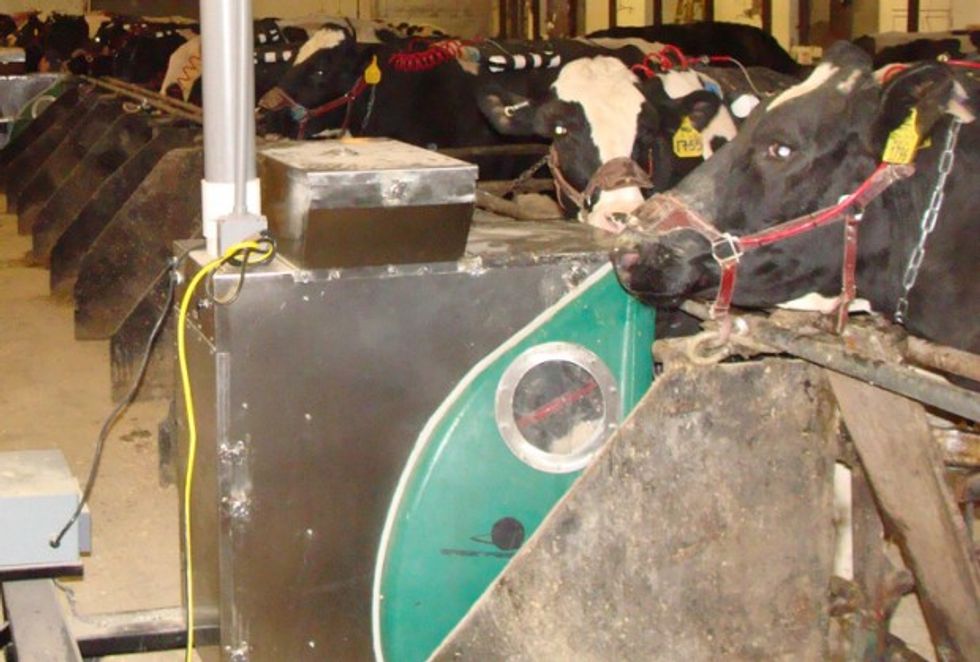
© 2026 Blaze Media LLC. All rights reserved.
Cow Burps Blamed for Contributing to Global Warming, So Here's What Scientists Are Doing About It
August 05, 2015
With the agricultural industry responsible for up to 7 percent of all the greenhouse gas emissions in the U.S., cattle have been cited for being accountable for up to 25 percent of the methane production in the country.
Their burps specifically.
But instead of requesting that people eat less beef or drink less milk to cut down the size of herds and thus reduce the gases that these cows belch out, researchers at Pennsylvania State University took a different approach. They went straight for their stomachs.

The scientists fed dairy cows a feed supplement that contained methane inhibitor 3-nitrooxypropanol. Evaluating the results of the 12-week study involving 48 Holsteins, they saw three important things:
1) Methane emissions from the cows receiving the supplement with the inhibitor were reduced by 30 percent.2) The cows eating the supplement gained 80 percent more body weight than the cows in the control group.
3) Cows eating the supplement did not appear to require more feed and their digestion and milk production remained the same.
The Penn State Extension College of Agricultural Sciences' website states that beef and dairy cows, goats and sheep are the main agricultural contributors to methane, which is 20 times more effective at trapping heat compared to carbon dioxide. Here's how they're involved:
The ruminant animal is unique because of its four stomach compartments: reticulum, rumen, omasum and abomasum. The rumen is a large, hollow muscular organ where microbial fermentation occurs. It can hold 40 to 60 gallons of material and an estimated 150 billion microorganisms per teaspoon are present in its contents. The function of the rumen as a fermentation vat and the presence of certain bacteria promote the development of gases. These gases are found in the upper part of the rumen with CO2 and CH4 making up the largest portion (Table 1). The proportion of these gases is dependent on rumen ecology and fermentation balance. Typically, the proportion of carbon dioxide is two to three times that of CH4, although a large quantity of CO2 is reduced to CH4. Approximately 132 to 264 gallons of ruminal gas produced by fermentation are belched each day. The eructation of gases via belching is important in bloat prevention but is also the way CH4 is emitted into the atmosphere.
Professor of dairy nutrition and lead author of the study Alexander Hristov said other compounds have been tested in feed to reduce livestock emissions before, but there were concerns about the animal's health and safety for public consumption of products that came from these animals afterward. This inhibitor seems safe, Hristov said in news release.
According to the university, the U.S. Food and Drug Administration would need to approve the inhibitor, which is made by a Dutch company, before it could be used on livestock here. As for why farmers might readily pay for the additive, Hristov said weight gain and milk production will be driving factors.
"The thing that is critical is body gain — dairy cows go through phases, and they lose a lot of weight when they calf. They don't eat enough, and they produce a lot of milk and lose weight, so if we can cut down the energy loss with the inhibitor, the animals will gain more body weight and recover more quickly," he said in a statement. "Further, they may produce more milk in early lactation and have improved reproduction. It's something that will convince producers to use it."
The research was published in the Proceedings of the National Academy of Sciences.
—
Front page image via Shutterstock.
Want to leave a tip?
We answer to you. Help keep our content free of advertisers and big tech censorship by leaving a tip today.
Want to join the conversation?
Already a subscriber?
more stories
Sign up for the Blaze newsletter
By signing up, you agree to our Privacy Policy and Terms of Use, and agree to receive content that may sometimes include advertisements. You may opt out at any time.
Related Content
© 2026 Blaze Media LLC. All rights reserved.
Get the stories that matter most delivered directly to your inbox.
By signing up, you agree to our Privacy Policy and Terms of Use, and agree to receive content that may sometimes include advertisements. You may opt out at any time.






